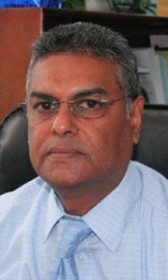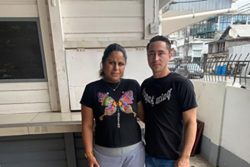-but one local group says it rescued 100
Minister of Labour Manzoor Nadir says he is unaware of any project in Guyana that removed 984 children from exploitive child labour but one of the groups involved said it saved 100 from such circumstances.

Nadir has strongly rejected the claim of the removal of 984 children from child labour made in the US 2010 Trafficking in Persons (TIP) report on Guyana.
“I have no knowledge of any project that accomplished that superhuman feat,” the minister told Stabroek News recently.
Nadir’s rejection of the claim follows the government’s strenuous objections to the entire TIP report on Guyana. Government has announced its intention to protest to the US Congress about the report as it said it is not accurate.
Ambassador-at-Large Luis C de Baca of the Office to Monitor and Combat Trafficking in Persons, speaking to reporters from Washington via a video link at the US Embassy on Tuesday said the information contained in the report was accurate and its sources were authentic. He said the US stands behind the report.
While the US did not give information on who compiled the report on the project, Nadir said the project being referred to was done by EduCare Guyana which would have closed its office here last year following the completion of the almost five-year project initiated under former minister of labour Dr Dale Bisnauth.
According to the 2010 TIP report, “during the reporting period the US Department of Labour reported results of a project that withdrew 984 children from exploitive child labour in logging and saw-milling, fishing, hazardous farming, factory work, mining, and freight handling from 2005 to 2009.”
Questioned about this report on Tuesday, the US Embassy provided a website which offered some more details on the report.
According to information provided on the website, “The project withdrew 984 children and prevented 2,084 children from exploitive child labour in logging and saw-milling, fishing, hazardous farming, factory work, mining, and freight handling. The geographic regions targeted include Regions Two, Three, Four, Five, as well as Bartica in Region Seven, Linden in Region Ten, and Georgetown.”
Under “problem addressed” the report stated that in 2000, UNICEF estimated that 27% of children ages 5 to 14 years (or 62,125 children of a total child population of 230,100) were working in Guyana.
According to Nadir, EduCare Guyana was expected to work with his ministry and the Ministry of Education but neither he nor his colleague Shaik Baksh had any knowledge of any such accomplishment and he labelled the claim as being “totally false.”
He said while he would have seen a midterm report in 2007 on the project, it included no such information. The final report that would have been compiled 15 months later was never shown to his ministry or the government, he said.
“They never had the courtesy of submitting the final report to government,” the minister stated.
The minister pointed out that if EduCare had come across any instance of child labour it was duty bound to inform the relevant government agencies so that legal action could be taken against those involved in the illegal act.
“Neither myself nor Minister Baksh was informed of any such instances,” the minister said while adding that he “vehemently rejected the information contained in the report.”
100 children
The project, entitled ‘Combating Exploitive Child Labor Through Education in Guyana’ and conducted between September 30, 2005 and March 31, 2009, listed its implementing partners as the Adult Education Association; Sunshine Women and Youth Group; Children of Hope Outreach; Roadside Baptist Church Skills Training Centre; Young Women’s Christian Association; Seventh-day Adventist Church Community Development Group; Denise Institute of Catering; Cotton Field Secondary; Golden Grove Concerned Residents; Ambassadors of Christ Ministries; New Amsterdam Practical Instruction Centre; Linden Technical Institute; Zeelugt Primary School; Fort Ordinance Parent Teachers Association; St Anthony’s Primary School; Essequibo Alliance; Arundel Congregational Church; West Berbice Women’s Group; Belladrum Primary; Alness Primary School; New Amsterdam Primary School; Enterprise Primary School; and Sophia Special School.
Stabroek News attempted to contact the organisations in an effort to ascertain the work they would have done in the project and while some were reluctant to speak others informed that the persons mandated to speak to the press were not in office. Some of the partners listed are schools and the heads of the schools were not prepared to speak to this newspaper.
However, Indrowattie Autar, who was the coordinator of the project for the Roadside Baptist Church Skills Training Centre in Berbice, confirmed that her organisation was a part of the project.
She said her organisation was mandated to take children who were involved in child labour and involve them in remedial education while teaching them a skill. She told Stabroek News that they were involved in two nine-month projects during which some 100 children were removed from child labour circumstances and were taught a skill. The children, who were between the ages of 13 and 17, were involved in jobs such as conducting tapirs, fishing, working at fish ports, farming, poultry, working as sales boys and girls. Some were also at home helping out in the family business. She said while most of the children had the desire to attend school they were forced to work by their parents.
The laws of Guyana allow a child at 15 to work and earlier this year Nadir had said that he was considering changing the legislation to facilitate children from the age of 13 doing some kinds of jobs.
Speaking at a March 18 press conference Nadir had said that child labour is not only a sensitive issue but one which is very often misunderstood and had stated that based on the records of the Ministry of Labour there have only been three reported cases of child labour in the past three years. “Child labour per se is not a big problem because we have a very poor understanding of what child labour is; what the law says in respect to the worst kinds of child labour and what child work is,” the minister had said.
The minister had said confusion surrounded the issue of truancy, which he admitted was a big problem locally, and child labour as persons just conclude that when a child skips school s/he is employed. Some 30 per cent of the country’s children do not complete their formal schooling – a figure the Ministry of Education hopes to cut in half this year.
Meanwhile, while the Guyana Conference of Seventh-day Adventists confirmed that it was part of the project and promised to give details on the work it did, it did not follow through.
Head the Adult Education Association (AEA) Patricia David declined to give this newspaper any information.
“The same source that said AEA was involved in the project, you go to them and let them give you the information,” she said. “I am not getting into that sort of thing.
“When AEA had its fiftieth anniversary celebration we invited your newspaper and you never turned up. Now that you see AEA was involved in something you are calling to find out. I find it so strange.”
Most of the organisations would have benefited from a $32.9 million grant in 2007 which was aimed at assisting children who fall victim to child labour and ensuring that they receive a sound education.
On its website the Partners of Americas, under which EduCare falls, described the programme as one funded by the United States Department of Labour and managed by them and is charged with combating child labour through education. “It is concentrating its resources on issues of child labour that come under the International Labour Organisation’s Convention 1982 on the worst forms of child labour. The organisation said many of the children it works with tend to fall into category ‘D’ – children who have dropped out of school for a variety of reasons. It provides assistance to two different sets of children the first being primary-aged children who are at risk of entering into child labour and with their partners in the communities the organisation provides uniforms, a daily hot meal and remedial after-school education programmes,” the website said
Under the EduCare Guyana project it was stated that while education is one of children’s most basic rights, in Guyana it is estimated that up to 27% of children undertake some form of work, and a significant number of these are involved in or at risk of involvement in the Worst Forms of Child Labour (WFCL). “High levels of poverty and a weak educational system have forced children into the work force, where they are subjected to hazardous work environments, contact with dangerous machinery, exposure to HIV/AIDS or other serious diseases, sexual exploitation, and trafficking in persons,” the project information said.
It said that children in Guyana work as porters, domestic servants, street vendors, and wait staff in bars and restaurants. Some are found working in sawmills and markets. The work done in sawmills includes fetching sawdust, cutting timber, and operating machinery used to shape logs, while the work done in markets mainly consists of selling goods. Children are known to work in mining and the illicit drug trade. There are reports of sexual exploitation of children in Guyana, including prostitution.







